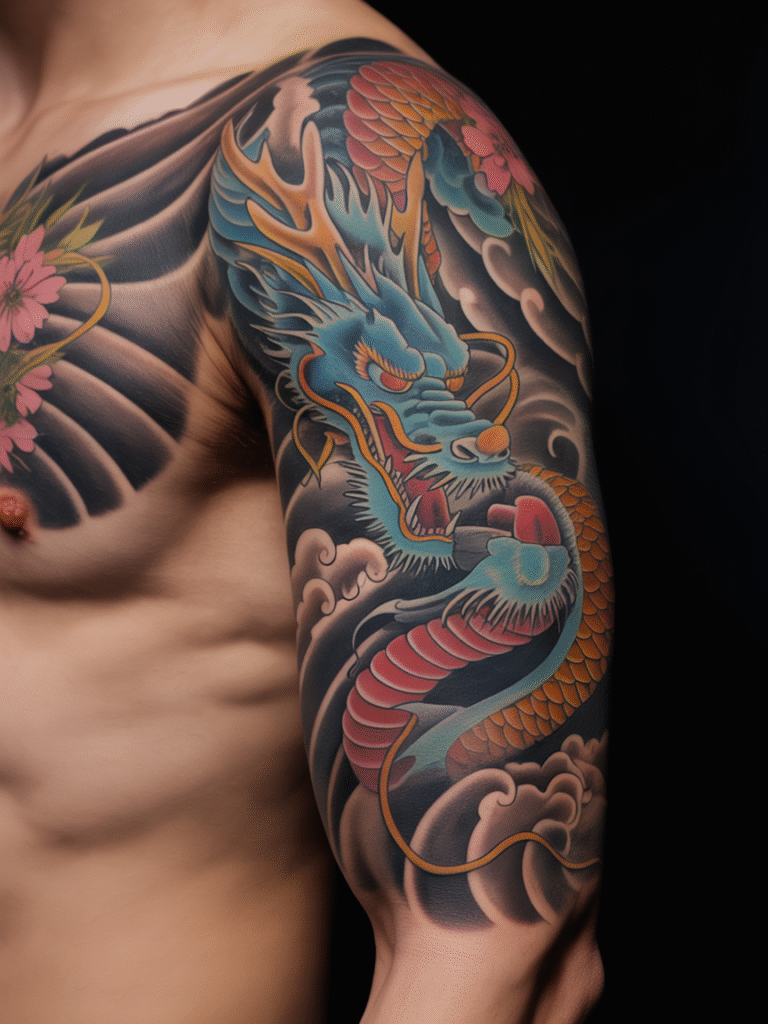Japanese dragon tattoos represent one of the most revered and powerful designs in traditional tattooing. These magnificent creatures, known as “Ryu” in Japanese culture, embody strength, wisdom, and good fortune. Unlike their Western counterparts, Japanese dragons are benevolent beings associated with water, weather, and imperial power.
1. The Rich History and Origins of Japanese Dragon Tattoos
Japanese dragon tattoos trace their roots back over a thousand years, originating from Chinese dragon mythology that was adapted and refined by Japanese culture. In ancient Japan, dragons were considered divine messengers and protectors of Buddhism. The art of tattooing dragons became prominent during the Edo period (1603-1868), when Japanese tattoo artists began incorporating these mythical beasts into elaborate body suits known as “irezumi.”
The tradition was heavily influenced by classical Japanese art forms, including woodblock prints and painted scrolls. Master tattoo artists would spend years perfecting their craft, creating intricate designs that told stories and conveyed deep spiritual meaning. These tattoos weren’t merely decorative; they were powerful talismans believed to protect the wearer and bring good fortune.
2. Deep Symbolism and Spiritual Meaning Behind Dragon Tattoos
Japanese dragons carry profound symbolic significance that extends far beyond their striking visual appeal. They represent the balance between opposing forces – chaos and order, destruction and creation. Dragons are seen as wise, benevolent creatures that bring rain for crops, control rivers and seas, and serve as guardians against evil spirits.
In Japanese culture, dragons symbolize strength, courage, and protection. They’re associated with imperial power and divine authority, making them popular choices for those seeking to embody leadership qualities. The dragon’s ability to move between earth, water, and sky represents versatility and adaptability – qualities highly valued in Japanese philosophy.
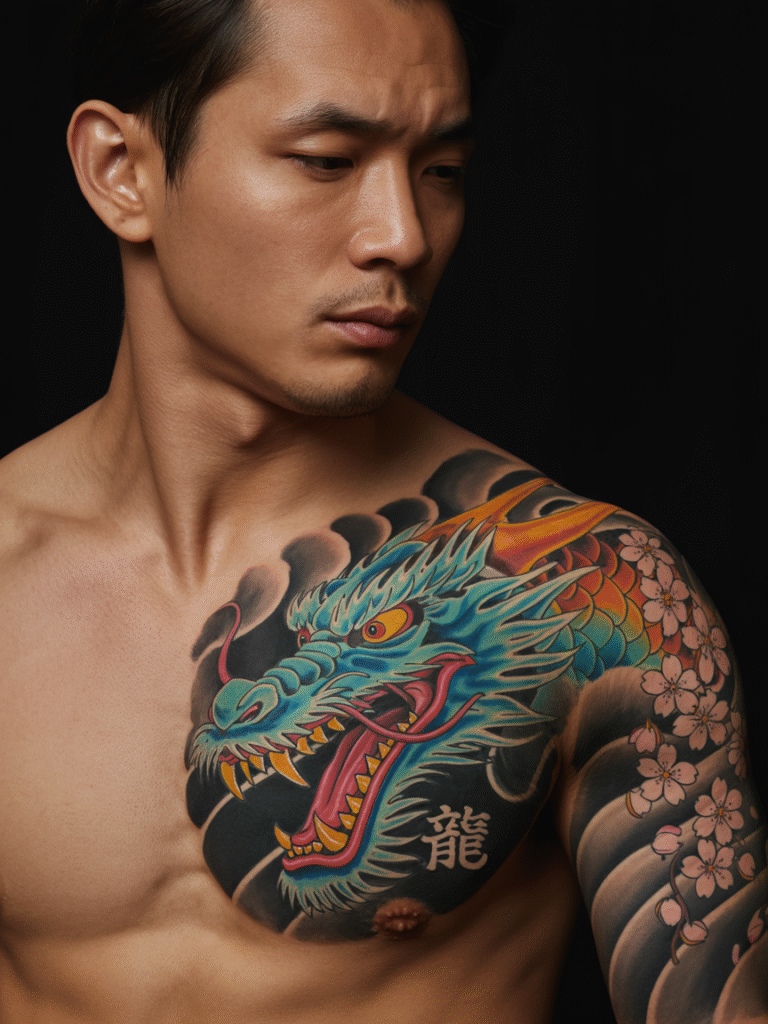
3. Traditional Japanese Dragon Design Elements and Characteristics
Authentic Japanese dragon tattoos feature distinctive design elements that set them apart from other cultural interpretations. These dragons typically have long, serpentine bodies covered in scales, four legs with sharp claws, and flowing whiskers. Their faces are more elongated and refined compared to Chinese dragons, often featuring fierce yet wise expressions.
Traditional color palettes include deep blues and greens for the dragon’s body, representing water and nature, while gold and red accents highlight important features like claws, teeth, and flame details. The dragons are usually depicted with flowing manes and surrounded by stylized clouds, waves, or wind patterns that enhance the sense of movement and power.
4. Popular Placement Options for Japanese Dragon Tattoos
The placement of a Japanese dragon tattoo significantly impacts both its visual impact and cultural authenticity. Traditional Japanese tattooing often involves large-scale pieces that flow with the body’s natural contours. The most popular placements include full chest pieces, where the dragon can spread majestically across the torso, and full sleeve designs that allow the dragon to wrap around the arm in a dynamic spiral.
Back pieces offer the largest canvas for elaborate dragon designs, often incorporating additional elements like cherry blossoms, waves, or mountains. Half-sleeve tattoos provide a more moderate option while still maintaining the flowing, organic feel essential to Japanese dragon art. The key is choosing a placement that allows the dragon to move naturally with your body’s lines and proportions.
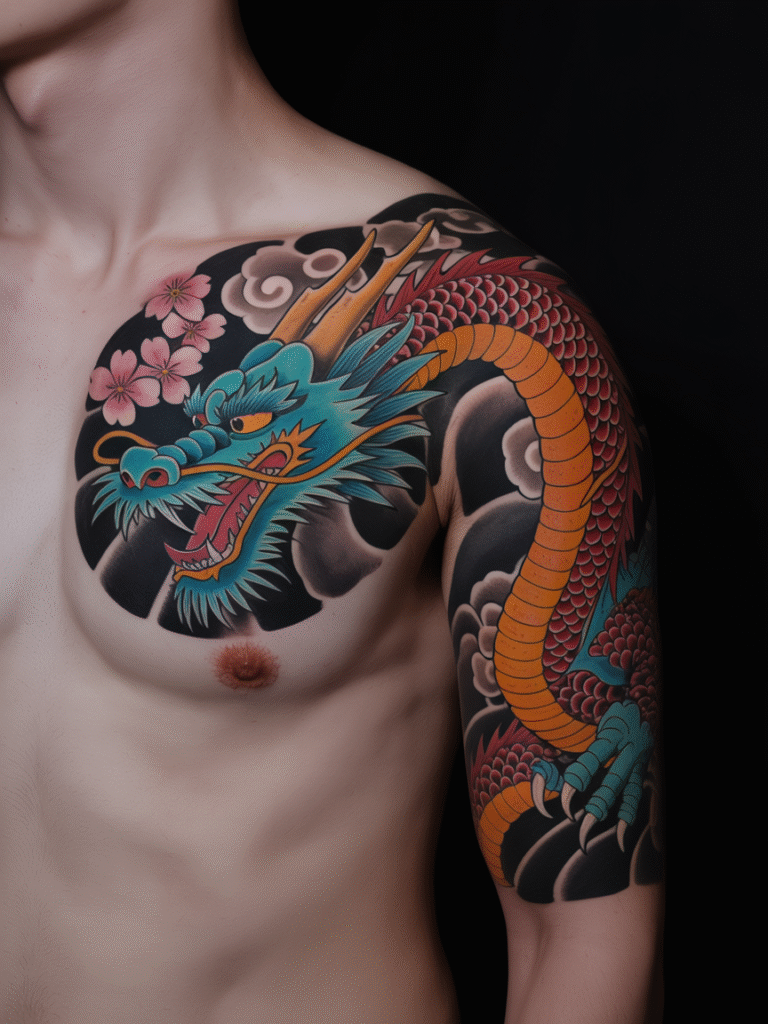
5. Color Schemes and Their Significance in Dragon Tattoos
Color plays a crucial role in Japanese dragon tattoos, with each hue carrying specific symbolic meaning. Blue and green dragons represent wisdom, tranquility, and connection to water elements. These colors are often chosen by those seeking peace and spiritual growth. Red dragons symbolize passion, strength, and good fortune, making them popular for those wanting to embody power and success.
Black and grey dragons offer a more subtle approach while maintaining dramatic impact. Golden dragons represent imperial power and divine authority, often chosen by leaders or those in positions of responsibility. The background elements also use meaningful colors – pink cherry blossoms for the fleeting nature of life, dark storm clouds for overcoming challenges, and flowing blue waves for adaptability and persistence.
6. Size Considerations and Scale Planning
Japanese dragon tattoos require careful size planning to achieve their full visual and symbolic impact. Small dragon tattoos, while possible, may lose the intricate details that make these designs so compelling. Medium-sized pieces (covering areas like the shoulder or upper arm) can capture essential elements while remaining manageable for first-time large tattoo recipients.
Large-scale dragon tattoos offer the most authentic experience, allowing for complete artistic expression and detailed storytelling. These pieces often take multiple sessions to complete and require significant commitment. The dragon’s body should flow naturally, whether coiling around an arm, stretching across a back, or dominating a chest piece. Proper scaling ensures that all elements remain proportional and visually balanced.
7. Complementary Elements: Cherry Blossoms, Waves, and Clouds
Traditional Japanese dragon tattoos rarely stand alone; they’re typically accompanied by complementary elements that enhance the overall composition and meaning. Cherry blossoms (sakura) are among the most popular additions, representing the beauty and transient nature of life. These delicate flowers create a stunning contrast against the dragon’s powerful form.
Water elements like waves and flowing streams emphasize the dragon’s connection to aquatic realms and natural forces. Stylized clouds and wind patterns add movement and depth, making the dragon appear to soar through the heavens. Other traditional elements include mountains for stability and endurance, bamboo for flexibility and strength, and traditional Japanese architectural elements for cultural authenticity.
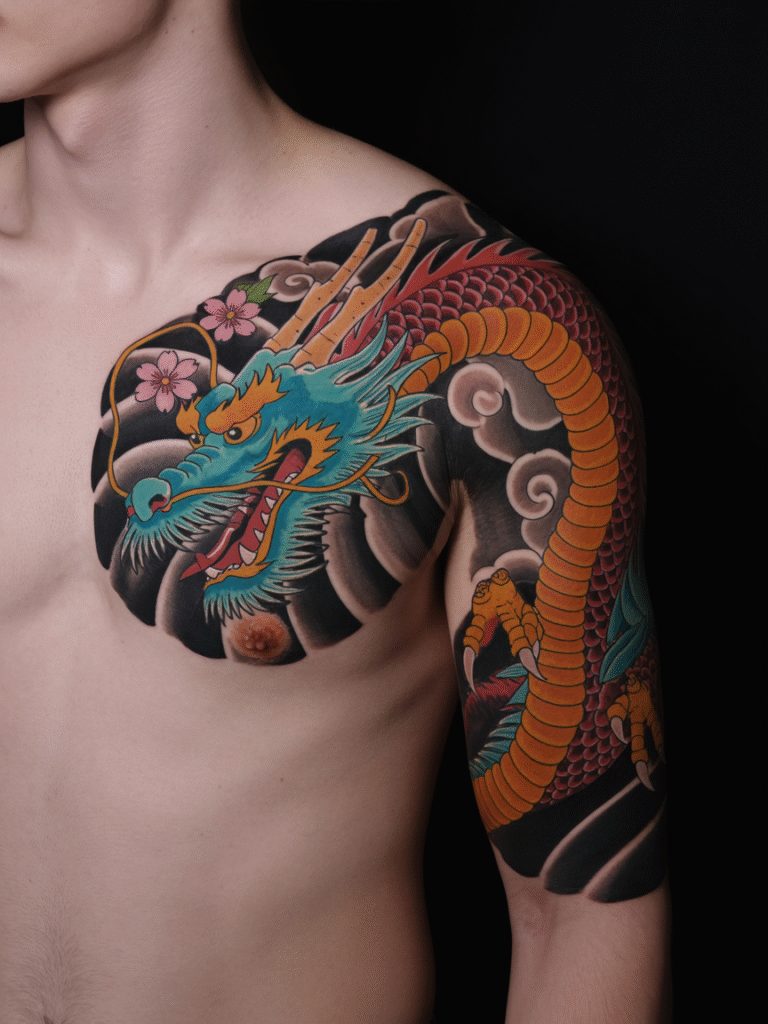
8. Choosing the Right Tattoo Artist for Your Dragon Design
Selecting the right artist for your Japanese dragon tattoo is crucial for achieving an authentic, high-quality result. Look for artists who specialize in Japanese traditional tattooing and have extensive portfolios showcasing dragon work. Authentic Japanese-style tattoos require specific techniques, including proper line work, shading methods, and color application that differs from other tattoo styles.
Research artists who understand the cultural significance and traditional design principles of Japanese tattooing. They should be able to discuss the symbolism behind different elements and help you create a design that’s both visually stunning and culturally respectful. Don’t hesitate to ask about their training, experience with large-scale pieces, and approach to traditional Japanese techniques.
9. The Tattooing Process: What to Expect
Getting a Japanese dragon tattoo, especially a large-scale piece, is a significant undertaking that requires patience and commitment. The process typically begins with extensive consultation and design development, where you’ll work with your artist to create a custom piece that fits your body and personal vision. This planning phase can take several weeks or even months for complex designs.
Large dragon tattoos often require multiple sessions, sometimes spanning several months or years. Each session typically lasts 3-6 hours, depending on the complexity and your pain tolerance. The artist will usually work in sections, completing entire areas before moving on to maintain consistency in healing and color saturation. Proper aftercare between sessions is crucial for optimal healing and color retention.
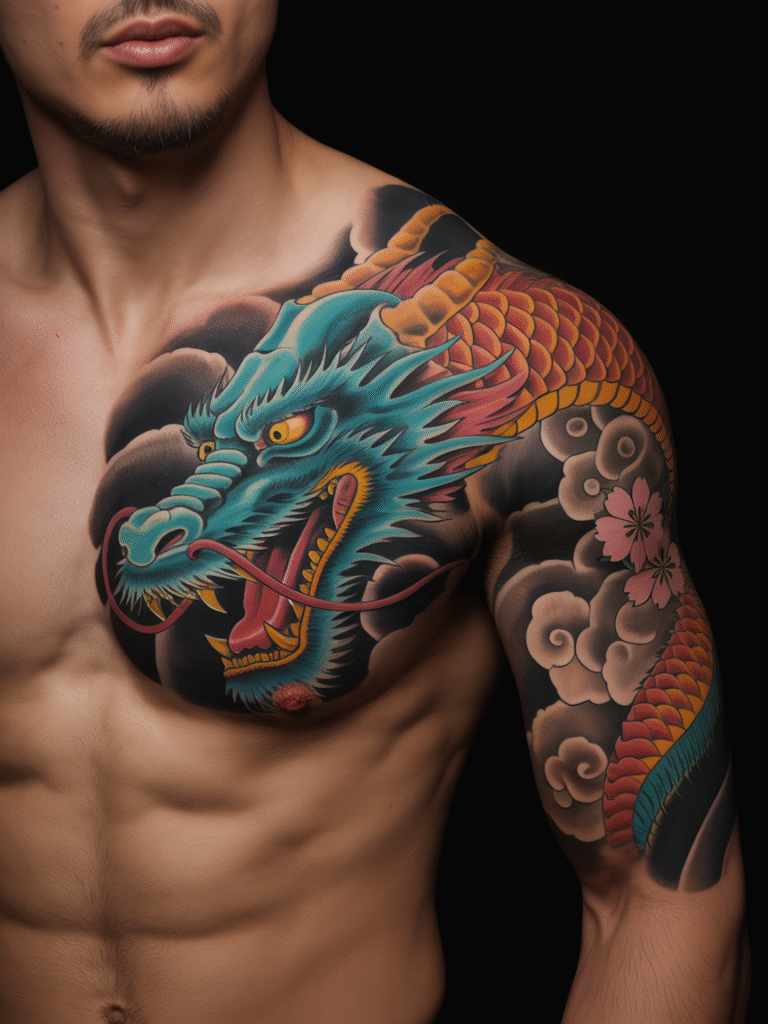
10. Aftercare and Healing for Large Dragon Tattoos
Proper aftercare is essential for Japanese dragon tattoos, particularly large-scale pieces with intricate details and bold colors. Follow your artist’s specific instructions, which typically include keeping the tattoo clean and moisturized while avoiding submersion in water during initial healing. The healing process for large tattoos can take several weeks, during which the tattoo may go through various stages of peeling and settling.
Pay special attention to color areas, as they may require extra care to maintain vibrancy. Avoid direct sunlight, excessive sweating, and tight clothing that might irritate the healing tattoo. Schedule follow-up appointments with your artist to assess healing progress and address any touch-ups that might be needed once the tattoo is fully healed.
11. Cultural Respect and Understanding in Japanese Tattoo Art
When choosing a Japanese dragon tattoo, it’s important to approach the design with cultural respect and understanding. Japanese tattooing carries deep cultural significance and historical context that extends beyond aesthetic appeal. Take time to learn about the symbolism and meaning behind your chosen design elements, and be prepared to explain and honor that significance.
Work with artists who understand and respect Japanese tattoo traditions, and avoid mixing elements from different cultural traditions without understanding their individual meanings. The goal is to create a tattoo that honors the rich heritage of Japanese art while expressing your personal connection to its symbolism and beauty.
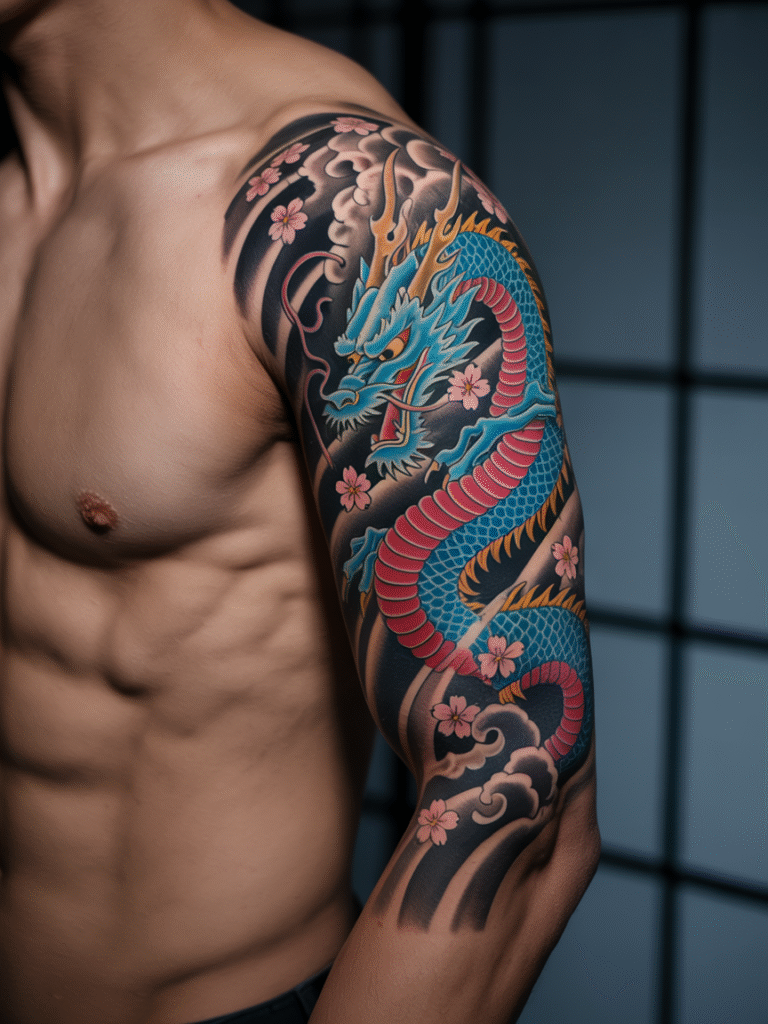
12. Modern Interpretations and Contemporary Styles
While traditional Japanese dragon tattoos follow established conventions, modern interpretations offer exciting possibilities for personal expression. Contemporary artists often blend traditional elements with modern techniques, creating pieces that honor classical principles while incorporating personal style. This might include updated color palettes, geometric elements, or modified proportions that suit modern aesthetic preferences.
Some artists specialize in neo-traditional Japanese styles that maintain cultural authenticity while adapting to contemporary tastes. These modern interpretations can include enhanced detail work, modified shading techniques, or integration with other tattoo styles. The key is maintaining respect for traditional symbolism and design principles while allowing for personal artistic expression.
13. Maintaining and Preserving Your Dragon Tattoo Long-term
A Japanese dragon tattoo represents a significant investment in both time and money, making long-term care essential for preserving its beauty and impact. Protect your tattoo from sun exposure by using high-SPF sunscreen, as UV rays can fade colors and blur fine details over time. Regular moisturizing helps maintain skin health and tattoo vibrancy.
Schedule periodic touch-ups with your original artist or a qualified specialist to address any fading or wear that naturally occurs over time. Quality Japanese dragon tattoos, when properly cared for, can maintain their striking appearance for decades. Consider your tattoo a piece of living art that requires ongoing attention and care to preserve its cultural significance and visual impact.
Your Japanese dragon tattoo will serve as a powerful symbol of strength, wisdom, and cultural appreciation for years to come, connecting you to centuries of artistic tradition and spiritual meaning.

